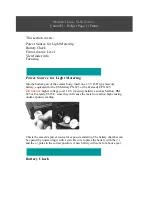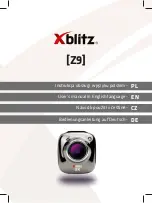
1-28
✔
Attachments—Do not use attachments that are not recommended. The use of such
attachments may cause hazards and cause serious damage to your camera.
✔
Power Sources—You should operate your camera only from the type of power
source indicated on the name plate of the AC adapter. If you are not sure of the type
of AC power that will be used, consult a dealer or local power company.
✔
Overloading—Do not overload power outlets and extension cords; this can result
in a risk of fire or electric shock.
✔
Flash Sync terminal— For a flash sync cable system ONLY! DO NOT
CONNECT AC MAIN POWER TO THIS CONNECTOR!
✔
Cables—Use only an IEEE 1394 cable to attach the camera to the computer. If you
use other cables, you may violate FCC emission requirements.
✔
Power-Cord Protections—Route power-supply, and other cords, so that you are
not likely to walk on them or pinch them with items placed on or against them. Pay
particular attention to cords at plugs, receptacles, and the point where they leave
your camera.
✔
Grounding—The AC adapter is equipped with a three-wire grounding-type plug
with a third (grounding) pin. The three-wire plug will fit into a grounding-type
power outlet. This is a safety feature. If you are unable to insert the plug into the
outlet, contact an electrician to replace the outlet. Do not defeat the safety purpose
of the grounding-type plug.
✔
Lightning—For added protection for your camera during a lightning storm, or any
time when you will leave your camera unattended and unused for long periods of
time, unplug the AC adapter from the power outlet and disconnect the camera from
the computer. This will protect your camera from damage caused by lightning or
power-line surges.
✔
PC Cards—PC Cards (not supplied with the camera) are fragile devices that can
be damaged if not treated with care. Refer to the documentation accompanying
your PC Cards to ensure that you are handling the PC Card as specified in that
documentation, and that you are using the PC Card within its operating ranges for
temperature, humidity, condensation, etc.
✔
Humidity, Condensation—We recommend operating your camera within the
range of 8% to 85% relative humidity, non-condensing. If condensation occurs,
added time may be required to read from or write to a PC Card. Condensation may
be present if the camera system and PC Cards are moved from a relatively cold
environment (like an air conditioned building), into a warm, humid environment.
We recommend that you allow sufficient time for the camera system and PC Cards
to normalize within the specified environmental ranges before operation. (PC
Cards may have more restrictive humidity ranges. Refer to the specifications that
came with your PC Cards.)
Содержание DCS 300 Series
Страница 1: ...USER S GUIDE FRONT COVER User sGuide forDCS300SeriesDigitalCameras DCS300SeriesDigitalCameras ...
Страница 2: ......
Страница 11: ...Contents Appendix E Focal Length Conversion E 1 Appendix F Problem Report F 1 ...
Страница 12: ......
Страница 43: ...1 31 1 Your Camera VCCI Statement ...
Страница 44: ......
Страница 82: ......
Страница 90: ......
Страница 132: ......
Страница 180: ......
Страница 246: ...E 2 ...
Страница 248: ......
















































